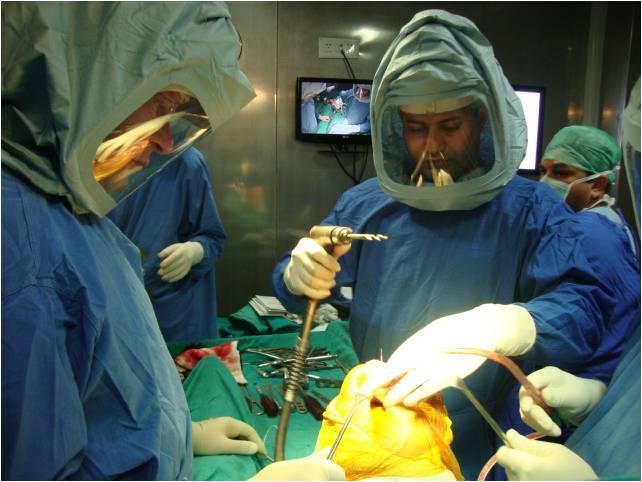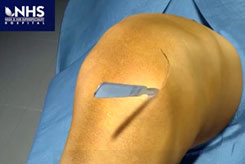Anxious about your surgery?
We’ve got you!



Your journey through a Robotic Knee Replacement Surgery
Futuristic technology is now helping thousands of people throughout the world, to get back on their feet and regain quality of life.
This guide will help you prepare for your surgery and recovery.
What is Robotic Knee replacement?

Total knee replacement surgery is a surgery in which the worn out or damaged surface of the knee joint is replaced with prosthetic artificial surface made up of special metals like chromium-cobalt, oxinium, titanium or polyethylene. The aim of this surgical procedure is to relieve you of your pain, deformity and swelling. So that you can get back to your active life. Now, that you have been suggested surgery, we help you plan and go for it.
How to prepare for your surgery?
After you have had your blood work and cardiac evaluation and have been found fit to undergo knee replacement surgery (unilateral is for a single knee and bilateral is for both knees together), you will be given a date for surgery as per your convenience.
Ask all questions you have in mind regarding the surgery and the implants from the doctor or the counsellor that day itself. At NHS Ortho Robotics, we do knee replacements every day, except on Sundays.
Fix up a date when you can have some family member around for surgery or some help by your side for a week or ten days later. A counsellor will help you with payments/ insurance approvals, if applicable.
Once the date is fixed, you will be provided a checklist to be handed over to the admission clerk on the day of surgery.
You will be asked to fast for 6-8 hours before surgery and report to NHS Hospital reception on the morning of surgery.
If you have any comorbidities (like hypertension, asthma, thyroid, gastritis), you may be asked to eat some your medicines with two sips of water early morning.
In the pre-operative/ recovery room, you will be made to change into hospital gown, leg hair will be removed and an IV canula for fluids may be put in one of your arm veins.
Some medication may be given to relax you as pre-anaesthesia and then you will be shifted to the operation theatre with clean laminar air, where you will be given anaesthesia for surgery.

What type of Anaesthesia is given?
Robotic knee replacement surgery usually takes 40 minutes. So, a spinal anaesthesia is enough. The anaesthetist will give an injection in the lower back which is a very fine prick and numbs the leg for around 3 hours. Occasionally, if there is a cardiac history or stiff/ fused spine, a general anaesthesia is preferred.
What happens during Robotic Surgery? Will the robot operate me?
Robotic knee replacement surgery is performed by the surgeon with the help of the robot. The surgeon will open up the knee, make a real time map of the deformed/ damaged surface ends of the bones and then using the robot plan the surgery. Once the surgery is virtually performed on the robotic screen, the robotic burrs are used to burr off/ shave off the surface and ligament balance is achieved throughout the range of movement, artificial implant is fitted on the surface. The wound is closed and dressing applied. You are then shifted to the recovery room!

What happens after the surgery?
In the recovery room, your vital signs are monitored and your family will be allowed to meet you. In two to three hours, you will be shifted to your room/ bed and a team of physiotherapists will come and make you stand and walk.
You will get certain medicines as injections in your canula for pain and to prevent infection over the next two three days in the hospital stay.
What kind of exercises/ precautions are needed?
Usually, the team of physiotherapists will make you walk, ensure that you start bending your knees and be able to climb stairs before you go home. You will be taught some exercises to practice and strengthen your muscles and gradually improve the range of movement of your knees. Most patients from urban areas prefer a physiotherapist coming home to help them exercise.
You will be encouraged to walk at least 40 minutes a day, exercise three to four times a day, sit in a high chair and use the toilet with the seat raised with an extender seat. You will also be allowed to use the stairs. Allowed to sit up for 1 hour but keep operated leg raised to avoid swelling.
You will be asked to use ICE packs on the operated knees thrice a day 10 minutes each. Use a plastic sheet to protect the dressing from getting wet. Same precautions for taking a bath. Sit in a plastic chair with the operated leg straight and covered in a plastic sheet or large towel so that it does not get wet.
Eat well with strict control of sugars. Watch out for redness/ discharge from operated knee or fever more than 101 degrees or severe pain. If dressing comes off, report to 9814209405/ 0181-4633333
Will I be given any medicines?
Some medicines to control pain, infection and clotting of blood will be given till you come next for removing the staples or wound check. You may also be asked to continue your medication from before surgery if any.
When do I come again?
Usually after discharge we call you after 8 days. If you have asked for a home dressing, we will help you with that and then your visit will be after one month from date of surgery, where we will HOPE to see you walk into the doctor’s office for an Xray and physical check of the knee. Fix up an appointment before coming for next visit.
ALL THE BEST FOR YOUR ROBOTIC HIP REPLACEMENT SURGERY.
FOR ANY CLARIFICATIONS, PLEASE FEEL FREE TO CONTACT US AT +91-8872463333
.png)
